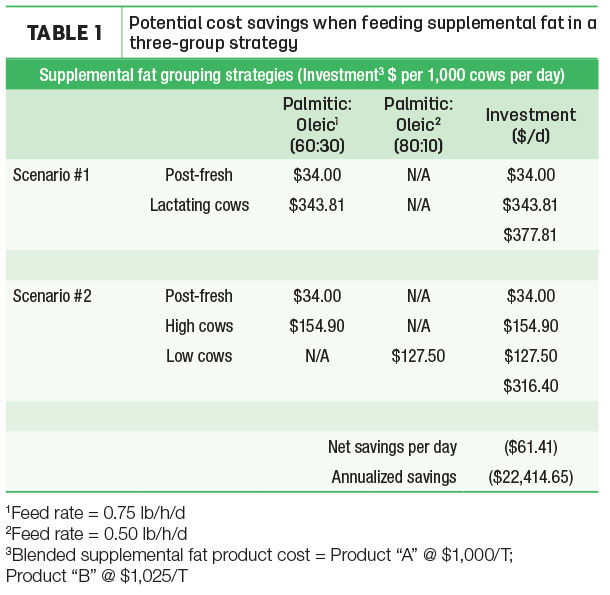But jiggering rations and swapping out feed ingredients can only go so far.
What if you changed the conversation to focus on feeding cows more efficiently? Instead of formulating rations to save costs, think about investing more on those cows with the potential to generate greater return on your ration investment.
Fresh-pen strategies
Dairy operations commonly group cows in a post-fresh pen for the first seven to 21 days of lactation. During this transition period, cows must overcome any postpartum disorders and ramp up feed intake to achieve high peak milk production. This is the time when it pays to invest resources to ensure cows get off to a good start.
During this period, provide adequate energy to help cows maintain healthy immune systems. Fresh cows also benefit from essential fatty acids (EFAs), including omega-3 and omega-6, to support reproductive success.
Cows are ready to move out of the fresh pen and into the lactating herd when they are increasing daily milk production and are not under veterinary treatment.
At this point, many operations manage cows in a single lactating cow group. With one lactation group, all cows get the same ration and supplements. For example, a herd may formulate rations for a target of 90 pounds of milk production per cow per day. Under that scenario, cows producing more than 90 pounds may not receive adequate nutrition, resulting in lower productivity.
Lower-producing cows may be overfed, resulting in higher overall ration costs and increased body conditioning that may make it harder to get these animals bred. By handling lactating cows in multiple groups, producers can reallocate feed dollars and optimize management for better cow performance and more efficient use of resources.
Ideal cow groups
The ideal lactating cow grouping strategy is one that works for you. Start by evaluating your cow numbers and looking for natural splits that will fit with your pen size and availability. Potential lactating cow pen divisions are:
- High-producing/low-producing
- Early lactation/late-lactation
- Breeding eligible/pregnant
For operations struggling with reproduction, pregnancy status may be a good grouping option. This allows for better synchronization scheduling and compliance. Larger operations may be able to form three or more lactating groups. For example, early lactation, mid-lactation and late-lactation.
With groups established, you and your nutritionist can hone your feed additive strategy, focusing on supplemental fat and a positive dietary cation-anion difference (DCAD).
Supplemental fat savings
When feeding supplemental fat for energy during lactation, it’s important to know each fatty acid has a different function in the cow’s body. Palmitic acid supports milk and milkfat production. Oleic acid works to replenish body reserves. Research shows fresh cows and high-producing cows (over 110 pounds of daily milk production) perform best with a ratio of 60 percent palmitic acid to 30 percent oleic acid. For lower-producing or later-lactation cows, the ideal ratio is 80 percent palmitic and 10 percent oleic.
Since the oleic acid is the higher-cost portion of the fat supplement, producers can save costs by changing the ratio to 80-to-10 for lower-producing cows rather than feeding 60-to-30 to all cows throughout lactation. With this strategy, a 1,000-cow herd could save more than $22,000 per year in supplemental fat costs alone. Table 1 details these potential cost savings.

Rethinking DCAD
Research shows distinct benefits when feeding lactating cows a ration with positive DCAD. As with supplemental fat, the optimal DCAD varies with the stage of lactation, creating another reason for strategic grouping. Here are recommended DCAD levels based on lactation stage:
- Transition: -8 to -12 meq (milliequivalent) per 100-gram ration dry matter
- Early lactation: +35 to +45 meq per 100-gram ration dry matter
- Late lactation: +30 meq per 100-gram ration dry matter
Keeping these targets in mind, work with your nutritionist to adjust DCAD for each lactating cow group, starting with wet chemistry analysis of all forages and byproduct feeds. Remember, water sources can contribute to dietary minerals.
Grouping for success
Producers may be concerned that multiple lactation groups require more labor and attention to feed mixing. But the potential for significant cost savings and increased cow performance make it worth your while to strategically group and manage cows for optimal economic return.
The same grouping principles apply to heifer raising. For tips on heifer grouping, check out “Rethink your heifer groups to optimize economic return” by my colleague Gene Boomer in the May 7 issue of Progressive Dairyman. In that article, Boomer discusses how producers can optimize economic return by handling heifers in appropriate groups and focusing on achieving fewer days on-feed and reduced costs per pound of gain. ![]()

-
Joel Pankowski
- Manager, Field Technical Services
- Arm & Hammer Animal and Food Production
- Email Joel Pankowski






